Varun Nagaraja
High Fidelity Text-Guided Music Generation and Editing via Single-Stage Flow Matching
Jul 04, 2024



Abstract:We introduce a simple and efficient text-controllable high-fidelity music generation and editing model. It operates on sequences of continuous latent representations from a low frame rate 48 kHz stereo variational auto encoder codec that eliminates the information loss drawback of discrete representations. Based on a diffusion transformer architecture trained on a flow-matching objective the model can generate and edit diverse high quality stereo samples of variable duration, with simple text descriptions. We also explore a new regularized latent inversion method for zero-shot test-time text-guided editing and demonstrate its superior performance over naive denoising diffusion implicit model (DDIM) inversion for variety of music editing prompts. Evaluations are conducted on both objective and subjective metrics and demonstrate that the proposed model is not only competitive to the evaluated baselines on a standard text-to-music benchmark - quality and efficiency-wise - but also outperforms previous state of the art for music editing when combined with our proposed latent inversion. Samples are available at https://melodyflow.github.io.
On The Open Prompt Challenge In Conditional Audio Generation
Nov 01, 2023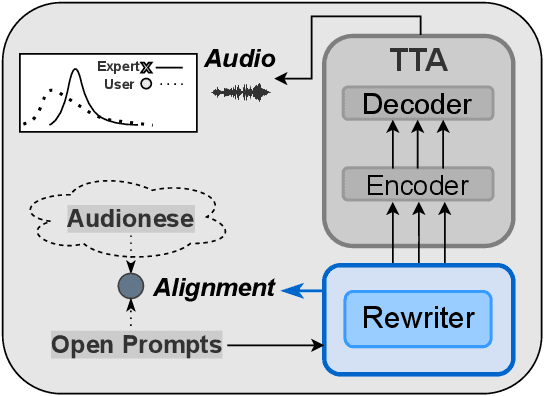
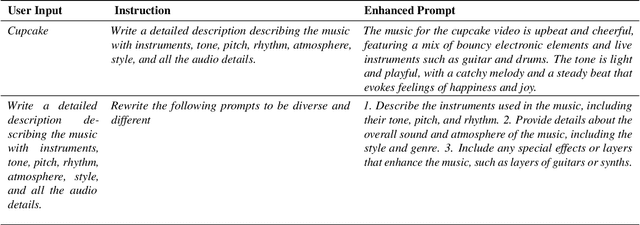
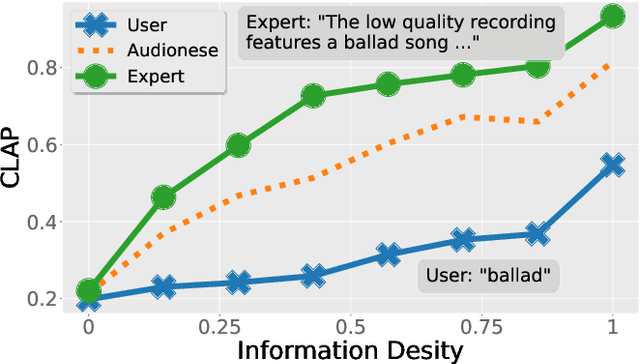

Abstract:Text-to-audio generation (TTA) produces audio from a text description, learning from pairs of audio samples and hand-annotated text. However, commercializing audio generation is challenging as user-input prompts are often under-specified when compared to text descriptions used to train TTA models. In this work, we treat TTA models as a ``blackbox'' and address the user prompt challenge with two key insights: (1) User prompts are generally under-specified, leading to a large alignment gap between user prompts and training prompts. (2) There is a distribution of audio descriptions for which TTA models are better at generating higher quality audio, which we refer to as ``audionese''. To this end, we rewrite prompts with instruction-tuned models and propose utilizing text-audio alignment as feedback signals via margin ranking learning for audio improvements. On both objective and subjective human evaluations, we observed marked improvements in both text-audio alignment and music audio quality.
FoleyGen: Visually-Guided Audio Generation
Sep 19, 2023Abstract:Recent advancements in audio generation have been spurred by the evolution of large-scale deep learning models and expansive datasets. However, the task of video-to-audio (V2A) generation continues to be a challenge, principally because of the intricate relationship between the high-dimensional visual and auditory data, and the challenges associated with temporal synchronization. In this study, we introduce FoleyGen, an open-domain V2A generation system built on a language modeling paradigm. FoleyGen leverages an off-the-shelf neural audio codec for bidirectional conversion between waveforms and discrete tokens. The generation of audio tokens is facilitated by a single Transformer model, which is conditioned on visual features extracted from a visual encoder. A prevalent problem in V2A generation is the misalignment of generated audio with the visible actions in the video. To address this, we explore three novel visual attention mechanisms. We further undertake an exhaustive evaluation of multiple visual encoders, each pretrained on either single-modal or multi-modal tasks. The experimental results on VGGSound dataset show that our proposed FoleyGen outperforms previous systems across all objective metrics and human evaluations.
Stack-and-Delay: a new codebook pattern for music generation
Sep 15, 2023Abstract:In language modeling based music generation, a generated waveform is represented by a sequence of hierarchical token stacks that can be decoded either in an auto-regressive manner or in parallel, depending on the codebook patterns. In particular, flattening the codebooks represents the highest quality decoding strategy, while being notoriously slow. To this end, we propose a novel stack-and-delay style of decoding strategy to improve upon the flat pattern decoding where generation speed is four times faster as opposed to vanilla flat decoding. This brings the inference time close to that of the delay decoding strategy, and allows for faster inference on GPU for small batch sizes. For the same inference efficiency budget as the delay pattern, we show that the proposed approach performs better in objective evaluations, almost closing the gap with the flat pattern in terms of quality. The results are corroborated by subjective evaluations which show that samples generated by the new model are slightly more often preferred to samples generated by the competing model given the same text prompts.
Enhance audio generation controllability through representation similarity regularization
Sep 15, 2023Abstract:This paper presents an innovative approach to enhance control over audio generation by emphasizing the alignment between audio and text representations during model training. In the context of language model-based audio generation, the model leverages input from both textual and audio token representations to predict subsequent audio tokens. However, the current configuration lacks explicit regularization to ensure the alignment between the chosen text representation and the language model's predictions. Our proposal involves the incorporation of audio and text representation regularization, particularly during the classifier-free guidance (CFG) phase, where the text condition is excluded from cross attention during language model training. The aim of this proposed representation regularization is to minimize discrepancies in audio and text similarity compared to other samples within the same training batch. Experimental results on both music and audio generation tasks demonstrate that our proposed methods lead to improvements in objective metrics for both audio and music generation, as well as an enhancement in the human perception for audio generation.
Streaming Transformer Transducer Based Speech Recognition Using Non-Causal Convolution
Oct 07, 2021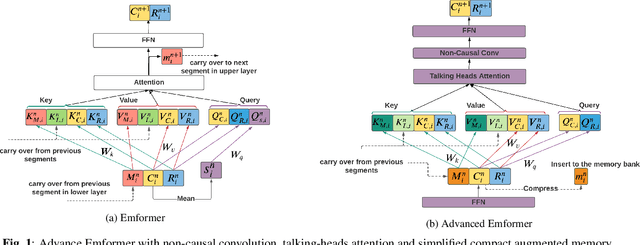
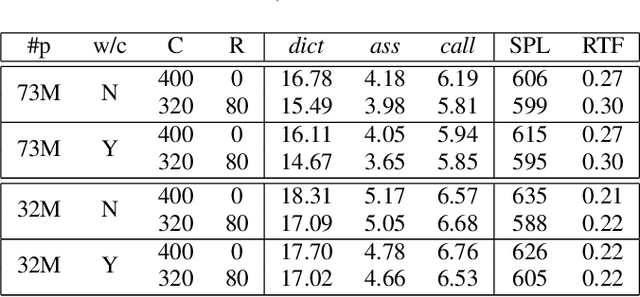
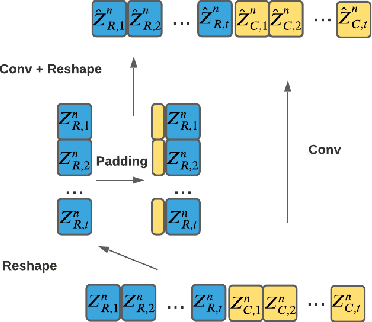
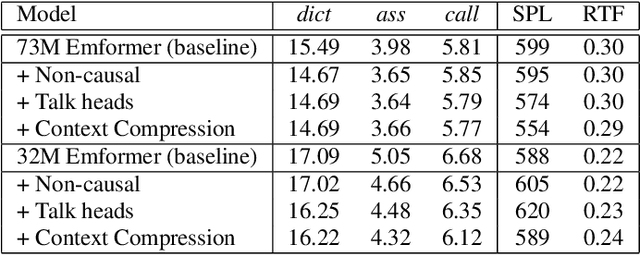
Abstract:This paper improves the streaming transformer transducer for speech recognition by using non-causal convolution. Many works apply the causal convolution to improve streaming transformer ignoring the lookahead context. We propose to use non-causal convolution to process the center block and lookahead context separately. This method leverages the lookahead context in convolution and maintains similar training and decoding efficiency. Given the similar latency, using the non-causal convolution with lookahead context gives better accuracy than causal convolution, especially for open-domain dictation scenarios. Besides, this paper applies talking-head attention and a novel history context compression scheme to further improve the performance. The talking-head attention improves the multi-head self-attention by transferring information among different heads. The history context compression method introduces more extended history context compactly. On our in-house data, the proposed methods improve a small Emformer baseline with lookahead context by relative WERR 5.1\%, 14.5\%, 8.4\% on open-domain dictation, assistant general scenarios, and assistant calling scenarios, respectively.
Collaborative Training of Acoustic Encoders for Speech Recognition
Jul 13, 2021


Abstract:On-device speech recognition requires training models of different sizes for deploying on devices with various computational budgets. When building such different models, we can benefit from training them jointly to take advantage of the knowledge shared between them. Joint training is also efficient since it reduces the redundancy in the training procedure's data handling operations. We propose a method for collaboratively training acoustic encoders of different sizes for speech recognition. We use a sequence transducer setup where different acoustic encoders share a common predictor and joiner modules. The acoustic encoders are also trained using co-distillation through an auxiliary task for frame level chenone prediction, along with the transducer loss. We perform experiments using the LibriSpeech corpus and demonstrate that the collaboratively trained acoustic encoders can provide up to a 11% relative improvement in the word error rate on both the test partitions.
Dynamic Encoder Transducer: A Flexible Solution For Trading Off Accuracy For Latency
Apr 05, 2021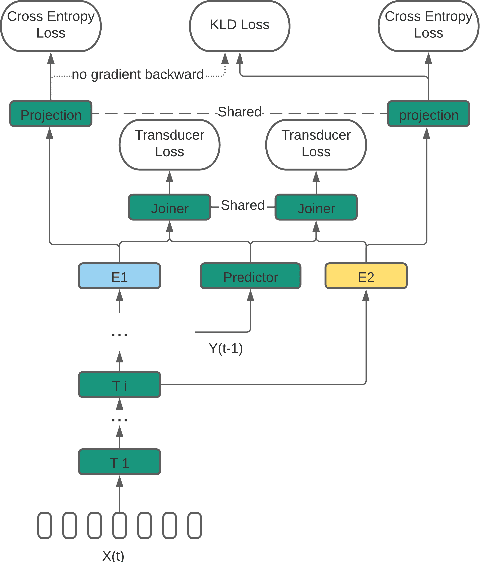
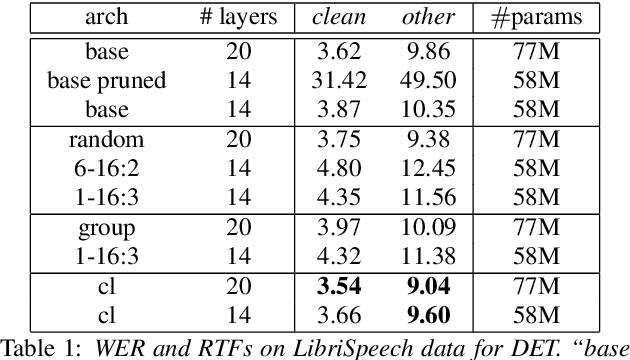
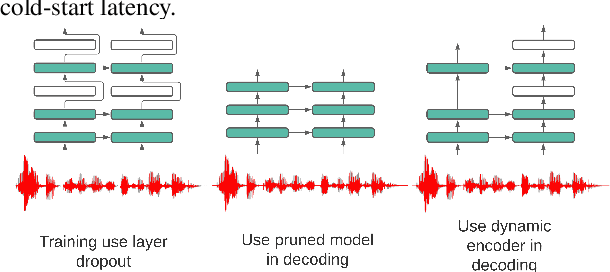
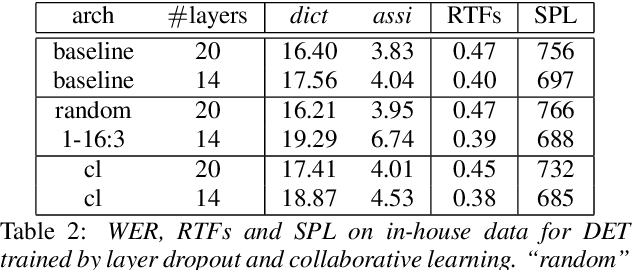
Abstract:We propose a dynamic encoder transducer (DET) for on-device speech recognition. One DET model scales to multiple devices with different computation capacities without retraining or finetuning. To trading off accuracy and latency, DET assigns different encoders to decode different parts of an utterance. We apply and compare the layer dropout and the collaborative learning for DET training. The layer dropout method that randomly drops out encoder layers in the training phase, can do on-demand layer dropout in decoding. Collaborative learning jointly trains multiple encoders with different depths in one single model. Experiment results on Librispeech and in-house data show that DET provides a flexible accuracy and latency trade-off. Results on Librispeech show that the full-size encoder in DET relatively reduces the word error rate of the same size baseline by over 8%. The lightweight encoder in DET trained with collaborative learning reduces the model size by 25% but still gets similar WER as the full-size baseline. DET gets similar accuracy as a baseline model with better latency on a large in-house data set by assigning a lightweight encoder for the beginning part of one utterance and a full-size encoder for the rest.
 Add to Chrome
Add to Chrome Add to Firefox
Add to Firefox Add to Edge
Add to Edge